2015 NISSAN VERSA SEDAN fuel
[x] Cancel search: fuelPage 348 of 374
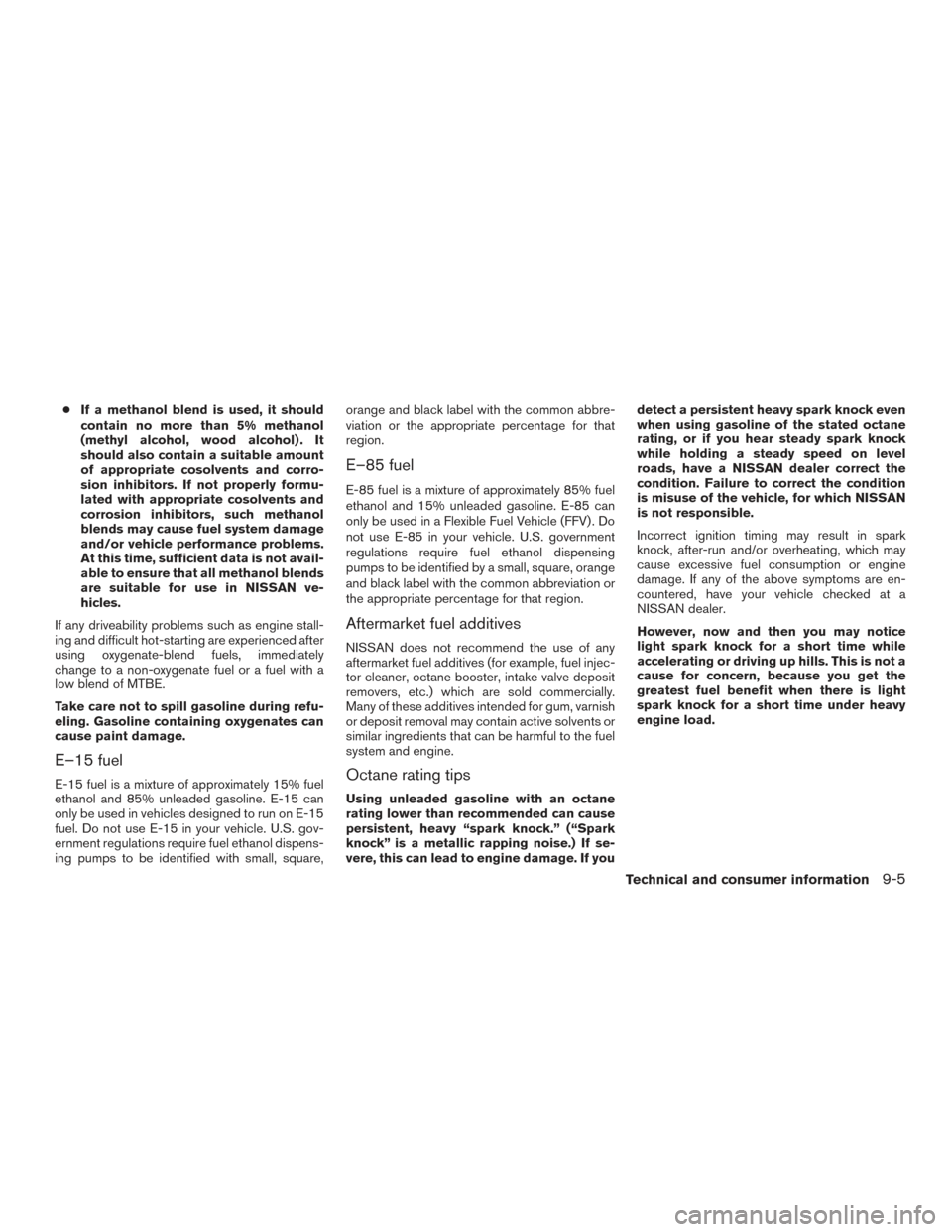
●If a methanol blend is used, it should
contain no more than 5% methanol
(methyl alcohol, wood alcohol) . It
should also contain a suitable amount
of appropriate cosolvents and corro-
sion inhibitors. If not properly formu-
lated with appropriate cosolvents and
corrosion inhibitors, such methanol
blends may cause fuel system damage
and/or vehicle performance problems.
At this time, sufficient data is not avail-
able to ensure that all methanol blends
are suitable for use in NISSAN ve-
hicles.
If any driveability problems such as engine stall-
ing and difficult hot-starting are experienced after
using oxygenate-blend fuels, immediately
change to a non-oxygenate fuel or a fuel with a
low blend of MTBE.
Take care not to spill gasoline during refu-
eling. Gasoline containing oxygenates can
cause paint damage.
E–15 fuel
E-15 fuel is a mixture of approximately 15% fuel
ethanol and 85% unleaded gasoline. E-15 can
only be used in vehicles designed to run on E-15
fuel. Do not use E-15 in your vehicle. U.S. gov-
ernment regulations require fuel ethanol dispens-
ing pumps to be identified with small, square, orange and black label with the common abbre-
viation or the appropriate percentage for that
region.
E–85 fuel
E-85 fuel is a mixture of approximately 85% fuel
ethanol and 15% unleaded gasoline. E-85 can
only be used in a Flexible Fuel Vehicle (FFV) . Do
not use E-85 in your vehicle. U.S. government
regulations require fuel ethanol dispensing
pumps to be identified by a small, square, orange
and black label with the common abbreviation or
the appropriate percentage for that region.
Aftermarket fuel additives
NISSAN does not recommend the use of any
aftermarket fuel additives (for example, fuel injec-
tor cleaner, octane booster, intake valve deposit
removers, etc.) which are sold commercially.
Many of these additives intended for gum, varnish
or deposit removal may contain active solvents or
similar ingredients that can be harmful to the fuel
system and engine.
Octane rating tips
Using unleaded gasoline with an octane
rating lower than recommended can cause
persistent, heavy “spark knock.” (“Spark
knock” is a metallic rapping noise.) If se-
vere, this can lead to engine damage. If youdetect a persistent heavy spark knock even
when using gasoline of the stated octane
rating, or if you hear steady spark knock
while holding a steady speed on level
roads, have a NISSAN dealer correct the
condition. Failure to correct the condition
is misuse of the vehicle, for which NISSAN
is not responsible.
Incorrect ignition timing may result in spark
knock, after-run and/or overheating, which may
cause excessive fuel consumption or engine
damage. If any of the above symptoms are en-
countered, have your vehicle checked at a
NISSAN dealer.
However, now and then you may notice
light spark knock for a short time while
accelerating or driving up hills. This is not a
cause for concern, because you get the
greatest fuel benefit when there is light
spark knock for a short time under heavy
engine load.
Technical and consumer information9-5
Page 349 of 374
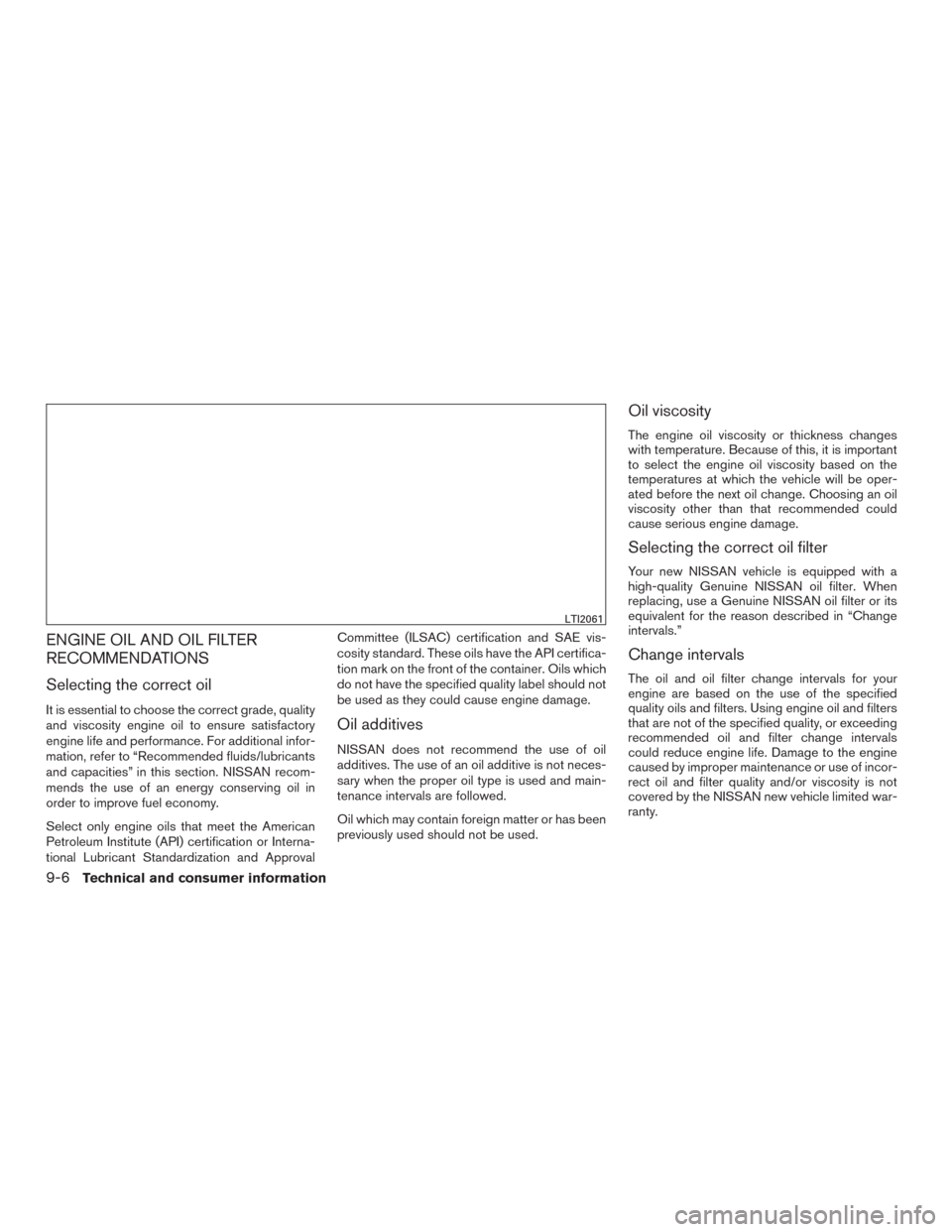
ENGINE OIL AND OIL FILTER
RECOMMENDATIONS
Selecting the correct oil
It is essential to choose the correct grade, quality
and viscosity engine oil to ensure satisfactory
engine life and performance. For additional infor-
mation, refer to “Recommended fluids/lubricants
and capacities” in this section. NISSAN recom-
mends the use of an energy conserving oil in
order to improve fuel economy.
Select only engine oils that meet the American
Petroleum Institute (API) certification or Interna-
tional Lubricant Standardization and ApprovalCommittee (ILSAC) certification and SAE vis-
cosity standard. These oils have the API certifica-
tion mark on the front of the container. Oils which
do not have the specified quality label should not
be used as they could cause engine damage.Oil additives
NISSAN does not recommend the use of oil
additives. The use of an oil additive is not neces-
sary when the proper oil type is used and main-
tenance intervals are followed.
Oil which may contain foreign matter or has been
previously used should not be used.
Oil viscosity
The engine oil viscosity or thickness changes
with temperature. Because of this, it is important
to select the engine oil viscosity based on the
temperatures at which the vehicle will be oper-
ated before the next oil change. Choosing an oil
viscosity other than that recommended could
cause serious engine damage.
Selecting the correct oil filter
Your new NISSAN vehicle is equipped with a
high-quality Genuine NISSAN oil filter. When
replacing, use a Genuine NISSAN oil filter or its
equivalent for the reason described in “Change
intervals.”
Change intervals
The oil and oil filter change intervals for your
engine are based on the use of the specified
quality oils and filters. Using engine oil and filters
that are not of the specified quality, or exceeding
recommended oil and filter change intervals
could reduce engine life. Damage to the engine
caused by improper maintenance or use of incor-
rect oil and filter quality and/or viscosity is not
covered by the NISSAN new vehicle limited war-
ranty.
LTI2061
9-6Technical and consumer information
Page 353 of 374
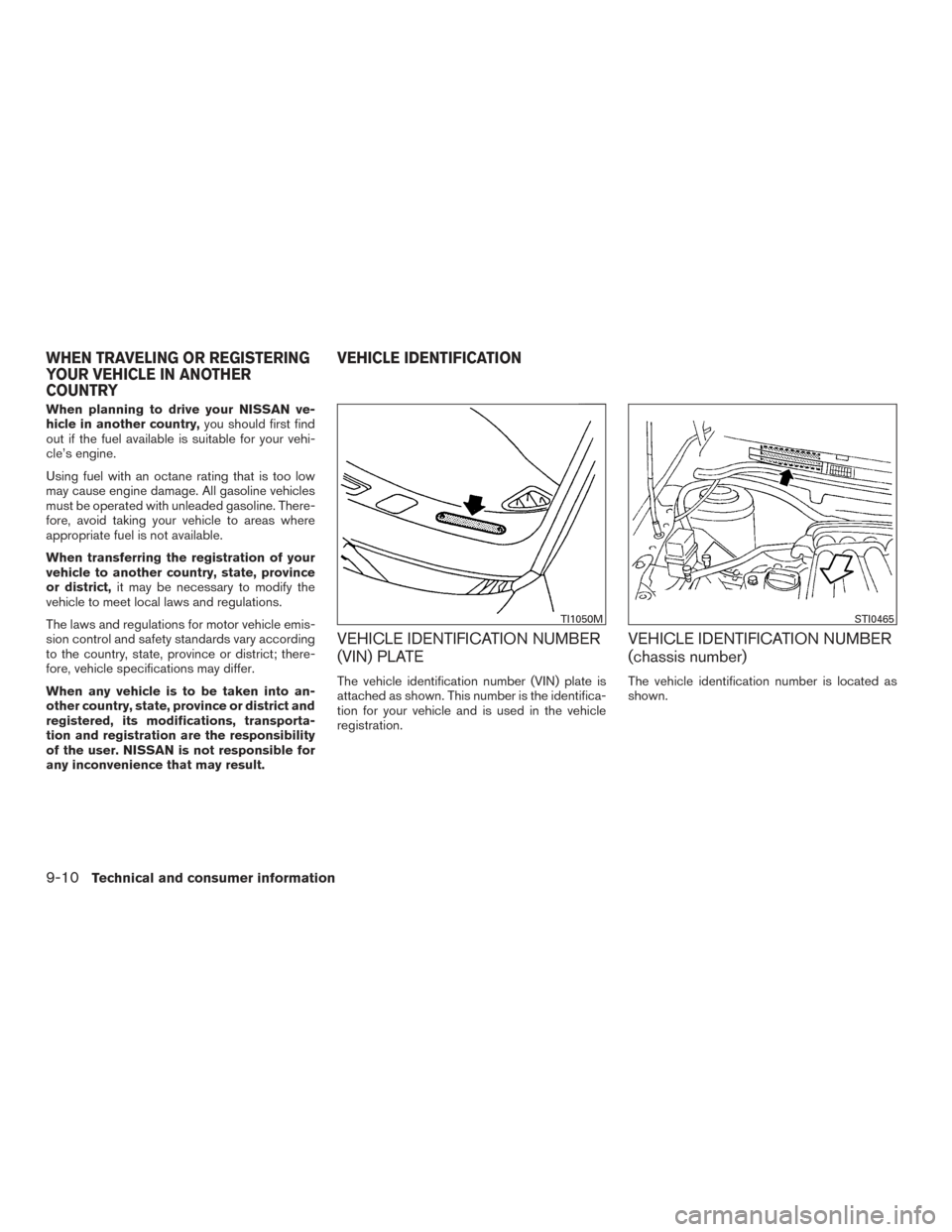
When planning to drive your NISSAN ve-
hicle in another country,you should first find
out if the fuel available is suitable for your vehi-
cle’s engine.
Using fuel with an octane rating that is too low
may cause engine damage. All gasoline vehicles
must be operated with unleaded gasoline. There-
fore, avoid taking your vehicle to areas where
appropriate fuel is not available.
When transferring the registration of your
vehicle to another country, state, province
or district, it may be necessary to modify the
vehicle to meet local laws and regulations.
The laws and regulations for motor vehicle emis-
sion control and safety standards vary according
to the country, state, province or district; there-
fore, vehicle specifications may differ.
When any vehicle is to be taken into an-
other country, state, province or district and
registered, its modifications, transporta-
tion and registration are the responsibility
of the user. NISSAN is not responsible for
any inconvenience that may result.
VEHICLE IDENTIFICATION NUMBER
(VIN) PLATE
The vehicle identification number (VIN) plate is
attached as shown. This number is the identifica-
tion for your vehicle and is used in the vehicle
registration.
VEHICLE IDENTIFICATION NUMBER
(chassis number)
The vehicle identification number is located as
shown.
TI1050MSTI0465
WHEN TRAVELING OR REGISTERING
YOUR VEHICLE IN ANOTHER
COUNTRY VEHICLE IDENTIFICATION
9-10Technical and consumer information
Page 367 of 374
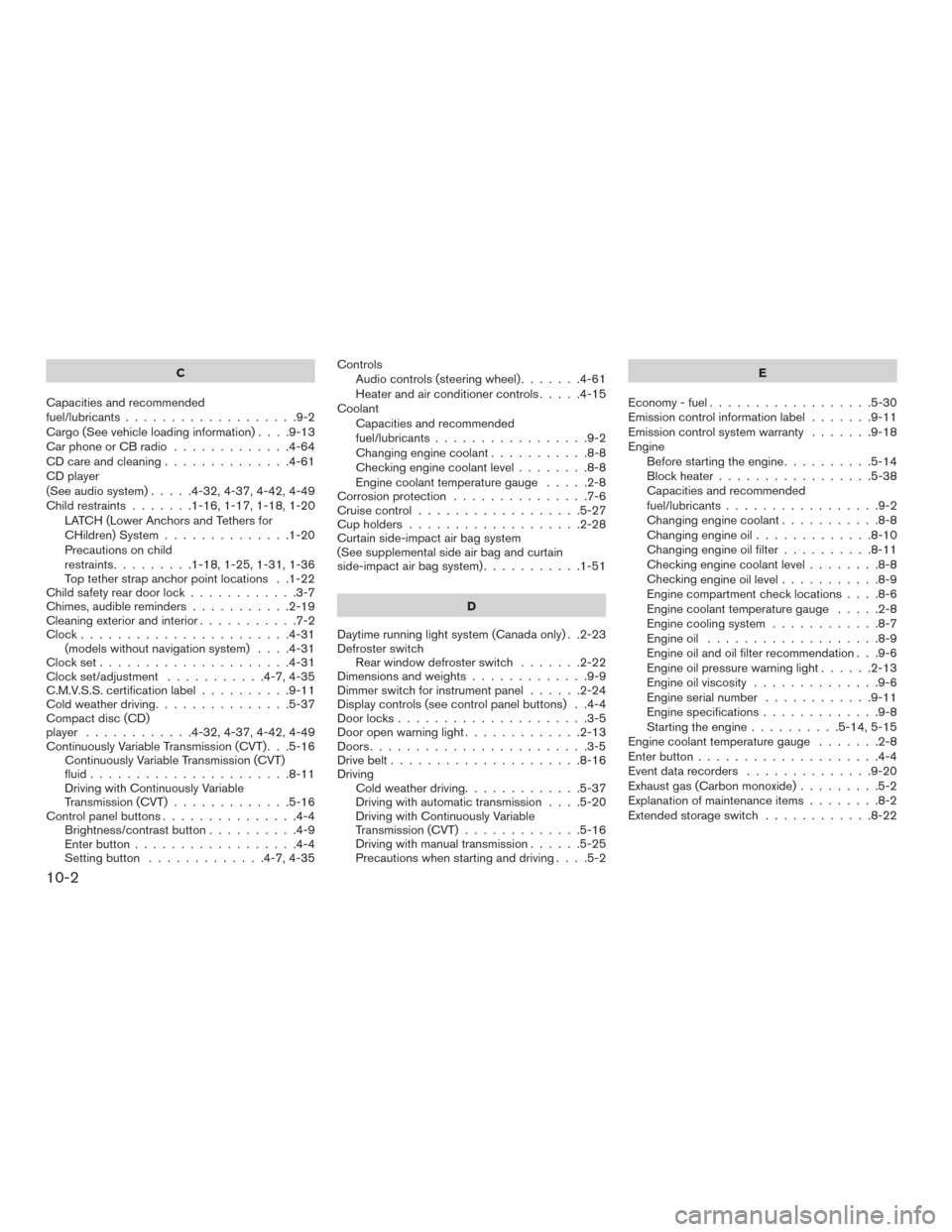
C
Capacities and recommended
fuel/lubricants ...................9-2
Cargo(Seevehicleloadinginformation)....9-13
Car phone or CB radio .............4-64
CD care and cleaning ..............4-61
CD player
(See audio system) .....4-32,4-37,4-42,4-49
Child restraints .......1-16,1-17,1-18,1-20
LATCH (Lower Anchors and Tethers for
CHildren) System ..............1-20
Precautions on child
restraints.........1-18,1-25,1-31,1-36
Top tether strap anchor point locations . .1-22
Child safety rear door lock ............3-7
Chimes, audible reminders ...........2-19
Cleaningexteriorandinterior...........7-2
Clock.......................4-31 (models without navigation system) ....4-31
Clockset.....................4-31
Clock set/adjustment ...........4-7,4-35
C.M.V.S.S. certification label ..........9-11
Cold weather driving ...............5-37
Compact disc (CD)
player ............4-32,4-37,4-42,4-49
Continuously Variable Transmission (CVT) . . .5-16 Continuously Variable Transmission (CVT)
fluid ......................8-11
Driving with Continuously Variable
Transmission (CVT) .............5-16
Control panel buttons ...............4-4
Brightness/contrast button ..........4-9
Enterbutton..................4-4
Setting button .............4-7,4-35 Controls
Audio controls (steering wheel) .......4-61
Heater and air conditioner controls .....4-15
Coolant Capacities and recommended
fuel/lubricants .................9-2
Changingenginecoolant...........8-8
Checking engine coolant level ........8-8
Engine coolant temperature gauge .....2-8
Corrosion protection ...............7-6
Cruisecontrol..................5-27
Cupholders...................2-28
Curtain side-impact air bag system
(See supplemental side air bag and curtain
side-impact air bag system) ...........1-51
D
Daytime running light system (Canada only) . .2-23
Defroster switch Rear window defroster switch .......2-22
Dimensionsandweights.............9-9
Dimmer switch for instrument panel ......2-24
Display controls (see control panel buttons) . .4-4
Door locks .....................3-5
Door open warning light .............2-13
Doors ........................3-5
Drive belt .....................8-16
Driving Cold weather driving .............5-37
Driving with automatic transmission ....5-20
Driving with Continuously Variable
Transmission (CVT) .............5-16
Driving with manual transmission ......5-25
Precautions when starting and driving ....5-2 E
Economy-fuel..................5-30
Emission control information label .......9-11
Emission control system warranty .......9-18
Engine Before starting the engine ..........5-14
Blockheater.................5-38
Capacities and recommended
fuel/lubricants.................9-2
Changing engine coolant ...........8-8
Changingengineoil.............8-10
Changing engine oil filter ..........8-11
Checking engine coolant level ........8-8
Checking
engine oil level ...........8-9
Engine compartment check locations ....8-6
Engine coolant temperature gauge .....2-8
Engine cooling system ............8-7
Engineoil ...................8-9
Engine oil and oil filter recommendation . . .9-6
Engine oil pressure warning light ......2-13
Engine oil viscosity ..............9-6
Engine serial number ............9-11
Engine specifications .............9-8
Starting the engine ..........5-14,5-15
Engine coolant temperature gauge .......2-8
Enter button ....................4-4
Event data recorders ..............9-20
Exhaust gas (Carbon monoxide) .........5-2
Explanation of maintenance items ........8-2
Extended storage switch ............8-22
10-2
Page 368 of 374

F
Flashers (See hazard warning flasher switch) . .6-2
Flat tire .......................6-3
Floor mat positioning aid .............7-6
Fluid Brake fluid ..................8-12
Capacities and recommended
fuel/lubricants .................9-2
Continuously Variable Transmission (CVT)
fluid......................8-11
Engine coolant .................8-7
Engine oil ...................8-9
F.M.V.S.S. certification label ...........9-11
Foglightswitch .................2-25
Front air bag system
(See supplemental restraint system) ......1-46
Frontseats.....................1-2
Fuel Capacities and recommended
fuel/lubricants .................9-2
Fuel economy ................5-30
Fuel-filler door and cap ...........3-27
Fuel-filler door lock opener lever ......3-27
Fuel gauge ...................2-9
Fuel octane rating ...............9-5
Fuel recommendation .............9-4
Loose fuel cap warning ........2-6,3-27
Fuel gauge .....................2-9
Fuses.......................8-20
Fusible links ...................8-20 G
Gascap .....................3-27
Gauge Engine coolant temperature gauge .....2-8
Fuel gauge ...................2-9
Odometer ...................2-5
Speedometer .................2-5
Tachometer ..................2-7
Trip computer .................2-9
Trip odometer .................2-5
General maintenance ...............8-2
Glovebox.....................2-29
H
Hands-free phone system,
Bluetooth®................4-65,4-90
Hazard warning flasher switch ..........6-2
Headlight and turn signal switch ........2-22
Headlight control switch ............2-22
Headlights ....................8-25
Head restraints ..................1-5
Heater Heater and air conditioner controls .....4-15
Heater operation ...............4-17
Hood release ...................3-24
Horn .......................2-25
I
Ignition switch ...................5-8
Ignition Switch Push-Button Ignition Switch ........5-11Immobilizer system
......2-19,3-4,5-10,5-14
Important vehicle information label .......9-11
Increasing fuel economy .............5-30
Indicator lights and audible reminders
(See warning/indicator lights and audible
reminders)....................2-11
Inside mirror ...................3-31
Instrument brightness control ..........2-24
Instrumentpanel...............0-6,2-2
Instrument panel dimmer switch ........2-24
Intelligent Key system Key operating range .............3-13
Key operation ................
3-15
Mechanical key ................3-4
Remote keyless entry operation.......3-18
Troubleshooting guide ............3-23
Warning signals ...............3-23
Interior light ................2-31,2-32
Interior trunk lid release .............3-26
iPod®Player ............... 4-54, 4-56
ISOFIX child restraints .............1-20
J
Jump starting ................6-8,8-15
K
Key.........................3-2
Key fob battery replacement ..........8-23
Keyless entry With Intelligent Key system
(See Intelligent Key system) .........3-18
10-3
Page 369 of 374
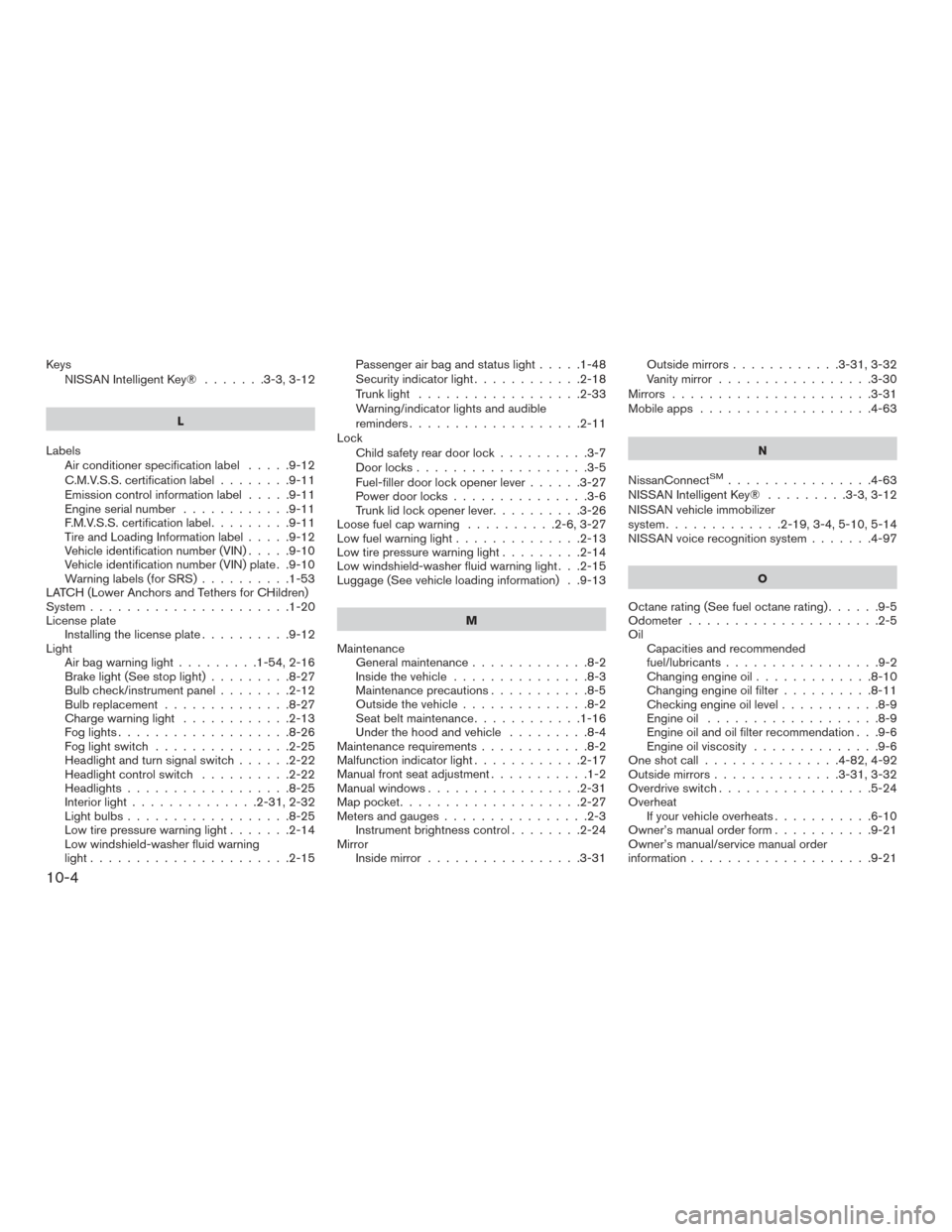
KeysNISSAN Intelligent Key® .......3-3,3-12
L
Labels Air conditioner specification label .....9-12
C.M.V.S.S. certification label ........9-11
Emissioncontrolinformationlabel.....9-11
Engine serial number ............9-11
F.M.V.S.S. certification label .........9-11
Tire and Loading Information label .....9-12
Vehicle identification number (VIN) .....9-10
Vehicle identification number (VIN) plate . .9-10
Warning labels (for SRS) ..........1-53
LATCH (Lower Anchors and Tethers for CHildren)
System ......................1-20
License plate Installing the license plate ..........9-12
Light Airbagwarninglight.........1-54,2-16
Brake light (See stop light) .........8-27
Bulb check/instrument panel ........2-12
Bulb replacement ..............8-27
Charge warning light ............2-13
Foglights...................8-26
Foglightswitch ...............2-25
Headlight and turn signal switch ......2-22
Headlight control switch ..........2-22
Headlights ..................8-25
Interiorlight..............2-31,2-32
Lightbulbs..................8-25
Low tire pressure warning light .......2-14
Low windshield-washer fluid warning
light......................2-15 Passenger air bag and status light
.....1-48
Security indicator light ............2-18
Trunklight ..................2-33
Warning/indicator lights and audible
reminders ...................2-11
Lock Child safety rear door lock ..........3-7
Door locks ...................3-5
Fuel-filler door lock opener lever ......3-27
Power door locks ...............3-6
Trunk lid lock opener lever ..........3-26
Loose fuel cap warning ..........2-6,3-27
Lowfuelwarninglight..............2-13
Low tire pressure warning light .........2-14
Low windshield-washer fluid warning light . . .2-15
Luggage (See vehicle loading information) . .9-13
M
Maintenance Generalmaintenance.............8-2
Insidethevehicle...............8-3
Maintenance precautions ...........8-5
Outside the vehicle ..............8-2
Seatbeltmaintenance............1-16
Underthehoodandvehicle .........8-4
Maintenancerequirements............8-2
Malfunction indicator light ............2-17
Manual front seat adjustment ...........1-2
Manual windows .................2-31
Map pocket ....................2-27
Meters and gauges ................2-3
Instrument brightness control ........2-24
Mirror Inside mirror .................3-31 Outside mirrors
............3-31,3-32
Vanity mirror .................3-30
Mirrors ......................3-31
Mobileapps ...................4-63
N
NissanConnect
SM................4-63
NISSAN Intelligent Key® .........3-3,3-12
NISSAN vehicle immobilizer
system .............2-19,3-4,5-10,5-14
NISSAN voice recognition system .......4-97
O
Octane rating (See fuel octane rating) ......9-5
Odometer .....................2-5
Oil Capacities and recommended
fuel/lubricants.................9-2
Changingengineoil.............8-10
Changing engine oil filter ..........8-11
Checking engine oil level ...........8-9
Engineoil ...................8-9
Engine oil and oil filter recommendation . . .9-6
Engine oil viscosity ..............9-6
Oneshotcall...............4-82,4-92
Outside mirrors ..............3-31,3-32
Overdrive switch .................5-24
Overheat If your vehicle overheats ...........6-10
Owner’s manual order form ...........9-21
Owner’s manual/service manual order
information ....................9-21
10-4
Page 372 of 374
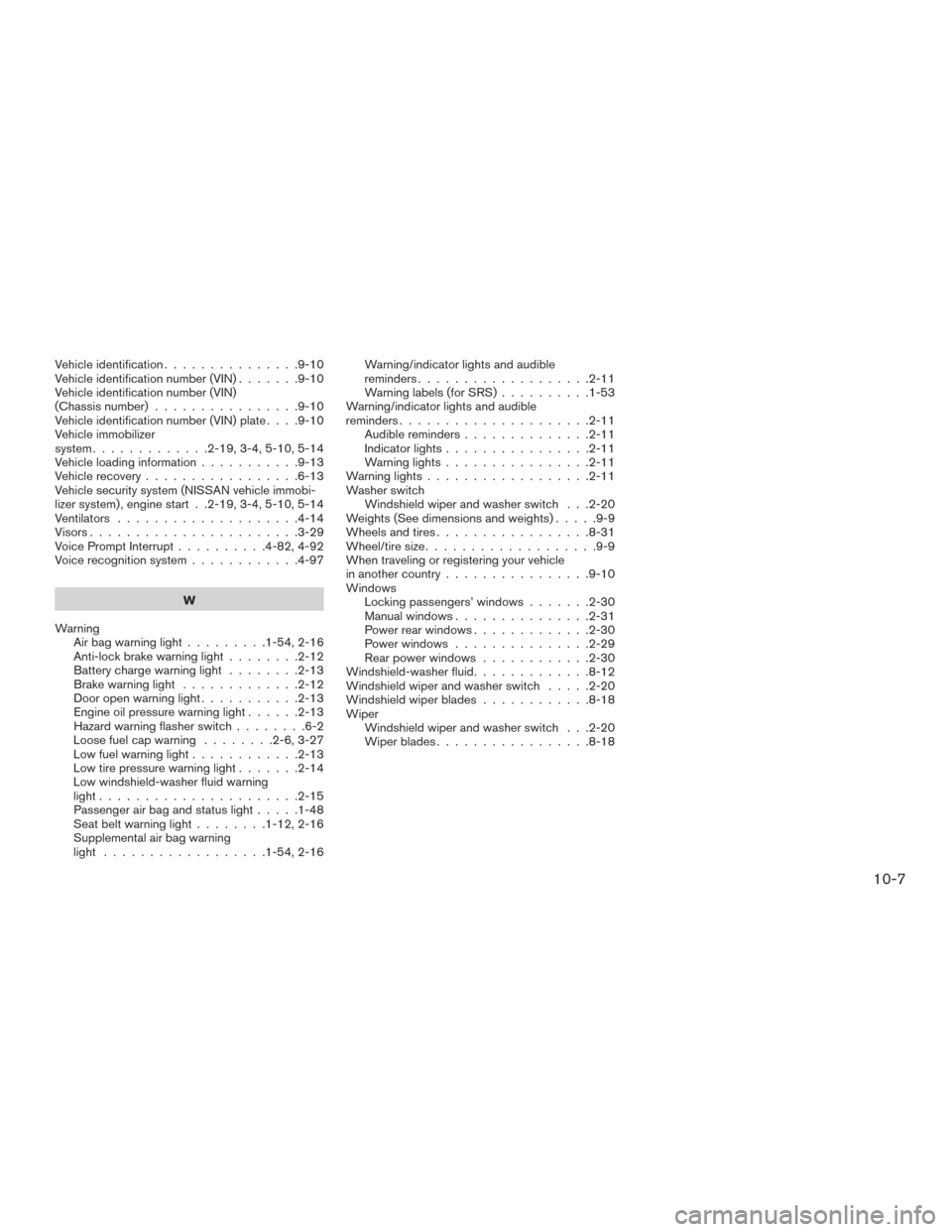
Vehicle identification...............9-10
Vehicle identification number (VIN) .......9-10
Vehicle identification number (VIN)
(Chassis number) ................9-10
Vehicle identification number (VIN) plate ....9-10
Vehicle immobilizer
system .............2-19,3-4,5-10,5-14
Vehicleloadinginformation...........9-13
Vehicle recovery .................6-13
Vehicle security system (NISSAN vehicle immobi-
lizer system) , engine start . .2-19, 3-4, 5-10, 5-14
Ventilators ....................4-14
Visors.......................3-29
Voice Prompt Interrupt ..........4-82,4-92
Voice recognition system ............4-97
W
Warning Airbagwarninglight.........1-54,2-16
Anti-lock brake warning light ........2-12
Battery charge warning light ........2-13
Brake warning light .............2-12
Door open warning light ...........2-13
Engine oil pressure warning light ......2-13
Hazard warning flasher switch ........6-2
Loose fuel cap warning ........2-6,3-27
Lowfuelwarninglight............2-13
Low tire pressure warning light .......2-14
Low windshield-washer fluid warning
light......................2-15
Passenger air bag and status light .....1-48
Seat belt warning light ........1-12,2-16
Supplemental air bag warning
light ..................1-54,2-16 Warning/indicator lights and audible
reminders...................2-11
Warning labels (for SRS)
..........1-53
Warning/indicator lights and audible
reminders.....................2-11 Audible reminders ..............2-11
Indicatorlights................2-11
Warninglights................2-11
Warninglights..................2-11
Washer switch Windshield wiper and washer switch . . .2-20
Weights(Seedimensionsandweights).....9-9
Wheels and tires .................8-31
Wheel/tire size ...................9-9
When traveling or registering your vehicle
in another country ................9-10
Windows Locking passengers’ windows .......2-30
Manual windows ...............2-31
Power rear windows .............2-30
Power windows ...............2-29
Rear power windows ............2-30
Windshield-washer fluid .............8-12
Windshield wiper and washer switch .....2-20
Windshieldwiperblades............8-18
Wiper Windshield wiper and washer switch . . .2-20
Wiperblades.................8-18
10-7
Page 373 of 374
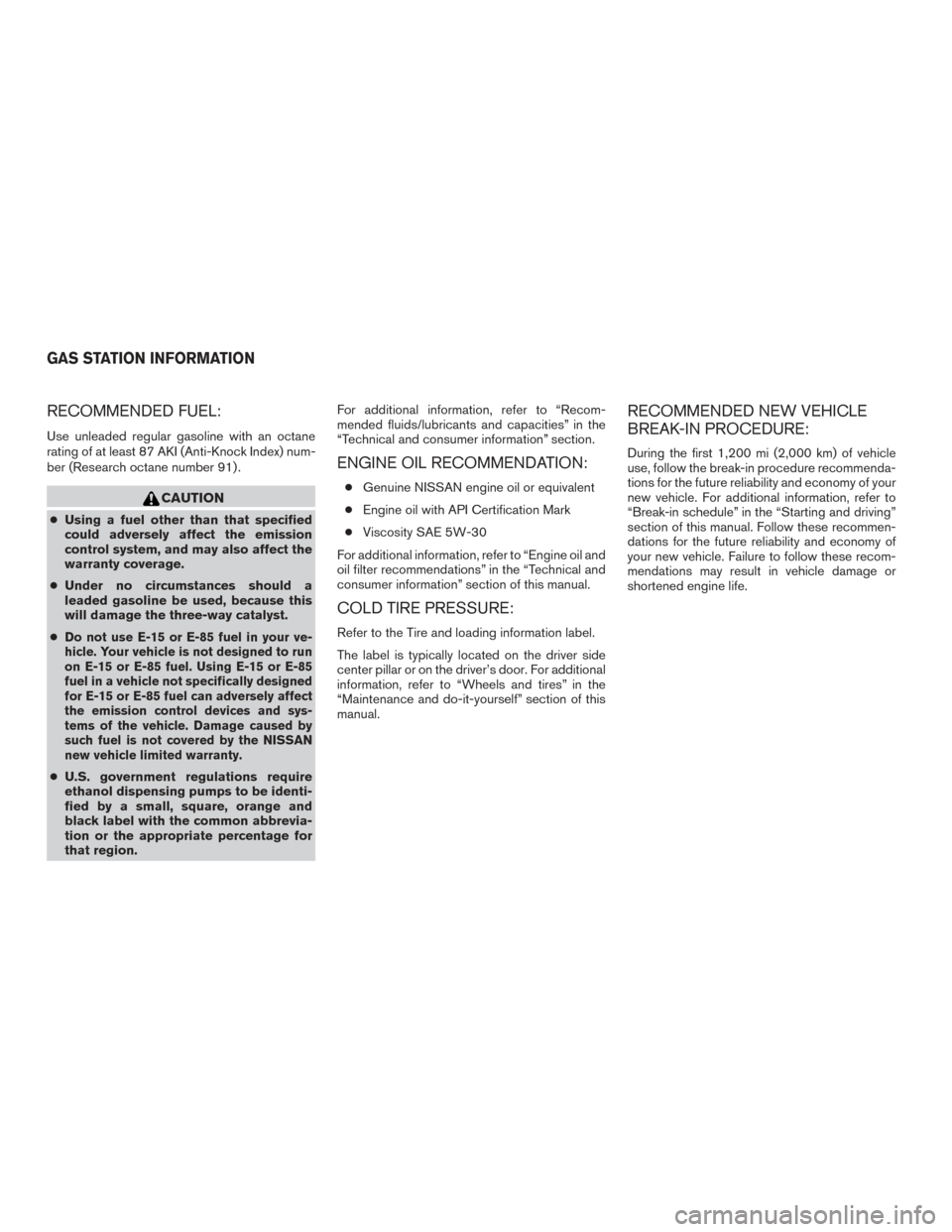
RECOMMENDED FUEL:
Use unleaded regular gasoline with an octane
rating of at least 87 AKI (Anti-Knock Index) num-
ber (Research octane number 91) .
CAUTION
●Using a fuel other than that specified
could adversely affect the emission
control system, and may also affect the
warranty coverage.
● Under no circumstances should a
leaded gasoline be used, because this
will damage the three-way catalyst.
●
Do not use E-15 or E-85 fuel in your ve-
hicle. Your vehicle is not designed to run
on E-15 or E-85 fuel. Using E-15 or E-85
fuel in a vehicle not specifically designed
for E-15 or E-85 fuel can adversely affect
the emission control devices and sys-
tems of the vehicle. Damage caused by
such fuel is not covered by the NISSAN
new vehicle limited warranty.
● U.S. government regulations require
ethanol dispensing pumps to be identi-
fied by a small, square, orange and
black label with the common abbrevia-
tion or the appropriate percentage for
that region. For additional information, refer to “Recom-
mended fluids/lubricants and capacities” in the
“Technical and consumer information” section.
ENGINE OIL RECOMMENDATION:
●
Genuine NISSAN engine oil or equivalent
● Engine oil with API Certification Mark
● Viscosity SAE 5W-30
For additional information, refer to “Engine oil and
oil filter recommendations” in the “Technical and
consumer information” section of this manual.
COLD TIRE PRESSURE:
Refer to the Tire and loading information label.
The label is typically located on the driver side
center pillar or on the driver’s door. For additional
information, refer to “Wheels and tires” in the
“Maintenance and do-it-yourself” section of this
manual.
RECOMMENDED NEW VEHICLE
BREAK-IN PROCEDURE:
During the first 1,200 mi (2,000 km) of vehicle
use, follow the break-in procedure recommenda-
tions for the future reliability and economy of your
new vehicle. For additional information, refer to
“Break-in schedule” in the “Starting and driving”
section of this manual. Follow these recommen-
dations for the future reliability and economy of
your new vehicle. Failure to follow these recom-
mendations may result in vehicle damage or
shortened engine life.
GAS STATION INFORMATION